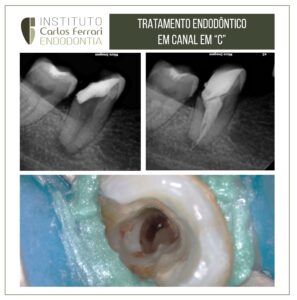Cirurgia paraendodôntica de pré-molar. Proservação de 12 meses.
Paciente encaminhada por colega especialista após não remissão da fístula depois de sucessivas trocas de medicação intracanal em segundo pré-molar superior direito. Decidiu-se então pela cirurgia paraendodôntica com apicectomia, após a obturação final realizada pela colega. A ressecção apical foi então realizada com ponta de ultrassom.No controle de 12 meses, ausência de sinais e sintomas e imagem radiográfica indicando a reparação da área, inclusive com o restabelecimento da imagem normal da cortical do seio maxilar.
in: Fagundes et al. Cirurgia paraendodôntica. Rev Odontol UNESP, Araraquara. set./out., 2011; 40(5): 272-277.
A evolução técnica, científica e biológica nos tratamentos de canais radiculares vem proporcionando aumento nos índices de sucesso. Entretanto, apesar de toda essa evolução, os tratamentos de canais radiculares são realizados, basicamente, por meio de passos operatórios técnicos que são sujeitos a falhas, acidentes e variados tipos de complicações em sua execução clínica. Diante do fracasso do tratamento de canal radicular, existe a possibilidade de seu retratamento; porém, nem sempre essa conduta é viável.
A cirurgia parendodôntica é um dos recursos utilizados toda vez que não for possível a remoção do agente etiológico via
endodonto, na tentativa de manter o elemento dentário. Além de oferecer a possibilidade de remover o tecido inflamado periapical, o mais importante: essa cirurgia possibilita melhorar a limpeza, a modelagem e o selamento da porção apical do canal radicular. Diversas são as indicações para a cirurgia parendodôntica, cabendo ao profissional eleger aquela que melhor se aplique
ao caso em questão. Dentre estas, citam-se: o estabelecimento de drenagem, o alívio de dor, as complicações anatômicas, os
problemas iatrogênicos, o traumatismo, as falhas em tratamentos previamente realizados, os problemas durante o tratamento, os
problemas periodontais e a necessidade de biópsia.
É indicada também em casos nos quais o prognóstico da obturação convencional seria duvidoso: perfuração radicular, ápices incompletos ou dilatados, elementos estranhos na região apical e periapical, e detecção de canais não obturados durante a inspeção transcirúrgica.
As modalidades cirúrgicas mais utilizadas para a resoluçãode dificuldades, acidentes e complicações na Endodontia
podem variar desde uma simples curetagem com alisamento ou plastia apical até a obturação do canal radicular simultânea ao ato cirúrgico. Esta implica na remoção do conteúdo do canal radicular, permitindo a obturação do mesmo mais efetivamente, bem como elimina a preocupação com eventual extrusão de material séptico e extravasamento de material obturador.
Além disso, Kuga et al. afirmam que, nos casos de perfuração radicular ou lesões com frequentes exacerbações, existe dificuldade na obtenção de canal seco e adequado à obturação.
Assim, esses autores reportam, ainda, que se removendo o material patológico do periápice, obtém-se um conduto ausente
de exsudação, permitindo a completa obturação. Nessa associaçãode obturação simultânea ao ato cirúrgico, se favorece a reparação apical, mormente no selamento de canais laterais, acessórios e secundários.
Cirurgia paraendodôntica
https://ferrariendodontia.com.br/cirurgia-canal-calcificado/





